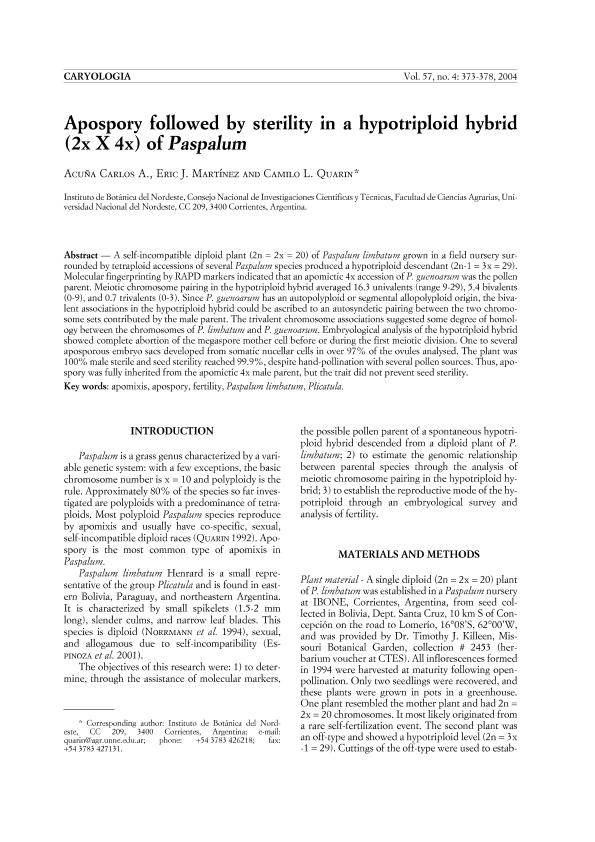Mostrar el registro sencillo del ítem
dc.contributor.author
Acuña, Carlos Alberto

dc.contributor.author
Martínez, Eric Javier

dc.contributor.author
Quarin, Camilo Luis

dc.date.available
2017-12-15T13:39:20Z
dc.date.issued
2004-12
dc.identifier.citation
Acuña, Carlos Alberto; Martínez, Eric Javier; Quarin, Camilo Luis; Apospory followed by sterility in a hypotriploid hybrid (2x X 4x) of Paspalum; Univ Florence Botany Inst; Caryologia; 27; 4; 12-2004; 373-378
dc.identifier.issn
0008-7114
dc.identifier.uri
http://hdl.handle.net/11336/30723
dc.description.abstract
A self-incompatible diploid plant (2n = 2x = 20) of Paspalum limbatum grown in a field nursery surrounded by tetraploid accessions of several Paspalum species produced a hypotriploid descendant (2n-1 = 3x = 29). Molecular fingerprinting by RAPD markers indicated that an apomictic 4x accession of P. guenoarum was the pollen parent. Meiotic chromosome pairing in the hypotriploid hybrid averaged 16.3 univalents (range 9-29), 5.4 bivalents (0-9), and 0.7 trivalents (0-3). Since P. guenoarum has an autopolyploid or segmental allopolyploid origin, the bivalent associations in the hypotriploid hybrid could be ascribed to an autosyndetic pairing between the two chromosome sets contributed by the male parent. The trivalent chromosome associations suggested some degree of homology between the chromosomes of P. limbatum and P. guenoarum. Embryological analysis of the hypotriploid hybrid showed complete abortion of the megaspore mother cell before or during the first meiotic division. One to several aposporous embryo sacs developed from somatic nucellar cells in over 97% of the ovules analysed. The plant was 100% male sterile and seed sterility reached 99.9%, despite hand-pollination with several pollen sources. Thus, apospory was fully inherited from the apomictic 4x male parent, but the trait did not prevent seed sterility.
dc.format
application/pdf
dc.language.iso
eng
dc.publisher
Univ Florence Botany Inst

dc.rights
info:eu-repo/semantics/openAccess
dc.rights.uri
https://creativecommons.org/licenses/by-nc-sa/2.5/ar/
dc.subject
Apomixis
dc.subject
Apospory
dc.subject
Fertility
dc.subject
Paspalum Limbatum
dc.subject
Plicatula
dc.subject.classification
Agricultura

dc.subject.classification
Agricultura, Silvicultura y Pesca

dc.subject.classification
CIENCIAS AGRÍCOLAS

dc.title
Apospory followed by sterility in a hypotriploid hybrid (2x X 4x) of Paspalum
dc.type
info:eu-repo/semantics/article
dc.type
info:ar-repo/semantics/artículo
dc.type
info:eu-repo/semantics/publishedVersion
dc.date.updated
2017-12-04T17:30:09Z
dc.identifier.eissn
2165-5391
dc.journal.volume
27
dc.journal.number
4
dc.journal.pagination
373-378
dc.journal.pais
Italia

dc.journal.ciudad
Florencia
dc.description.fil
Fil: Acuña, Carlos Alberto. Consejo Nacional de Investigaciones Científicas y Técnicas. Centro Científico Tecnológico Conicet - Nordeste. Instituto de Botánica del Nordeste. Universidad Nacional del Nordeste. Facultad de Ciencias Agrarias. Instituto de Botánica del Nordeste; Argentina
dc.description.fil
Fil: Martínez, Eric Javier. Consejo Nacional de Investigaciones Científicas y Técnicas. Centro Científico Tecnológico Conicet - Nordeste. Instituto de Botánica del Nordeste. Universidad Nacional del Nordeste. Facultad de Ciencias Agrarias. Instituto de Botánica del Nordeste; Argentina
dc.description.fil
Fil: Quarin, Camilo Luis. Consejo Nacional de Investigaciones Científicas y Técnicas. Centro Científico Tecnológico Conicet - Nordeste. Instituto de Botánica del Nordeste. Universidad Nacional del Nordeste. Facultad de Ciencias Agrarias. Instituto de Botánica del Nordeste; Argentina
dc.journal.title
Caryologia

dc.relation.alternativeid
info:eu-repo/semantics/altIdentifier/doi/http://dx.doi.org/10.1080/00087114.2004.10589419
dc.relation.alternativeid
info:eu-repo/semantics/altIdentifier/url/http://www.tandfonline.com/doi/abs/10.1080/00087114.2004.10589419
Archivos asociados
